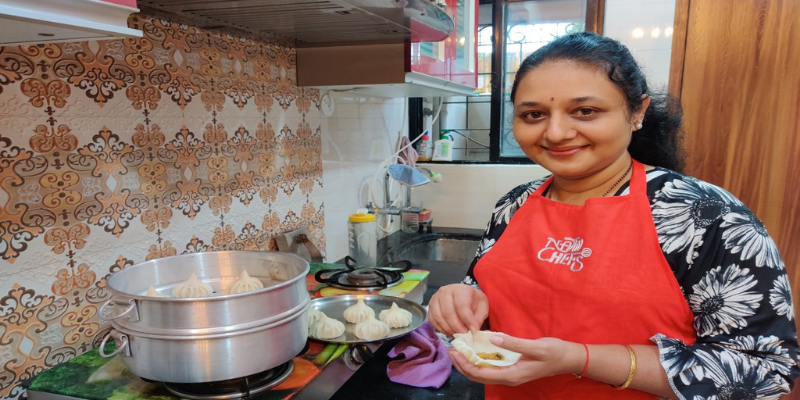
After receiving Lord Ganesha’s blessings, let your tastebuds taste our ukadiche modak and fried modak. We are sure you will give in to your cravings and keep wanting more.
When you open the box of Modaks, the burst of aroma accentuates the whole experience. Well, this blog is about those hands which prepared these sweet delights.
Chef Anuradha was born and brought up in a Maharashtrian household where every festival is celebrated with great enthusiasm. Being brought up in a joint family where guests are frequently visiting and food always cooking, and the cultural palette that her mom and her aunts brought with them gave her a chance to relish the different flavors of Maharashtra. But Modaks always had a special place in her heart. She reminisces the time when she used to watch her mother and grandmother making modaks, which provoked her interest in modaks. She even says that she knows how to make them from a very early age and also says that it took her a lot of practice to get those ‘kaliyas’ right.
So, one fine day our Chef Community team went to her place for a small interview. They wanted to know about her experience in executing the orders, which then lead to a whole thread of conversations knotted with a lot of sweet memories and experiences, which made her who she is today.
Starting with her childhood, she was born and raised in a joint family that resides in a small town in Maharashtra. “You could see as to how amazing her childhood was by just looking at her smile when she talks about it,” says one of the members from the Chef’s Community department, and as already mentioned Modaks were the most cherished chapter of her childhood. Completed her 12th in Science, she did her graduation in Bachelors of Arts and Masters of Arts from her hometown. She was working as a teacher when she got married and left her hometown, and started her new life in the city of oranges, Nagpur.
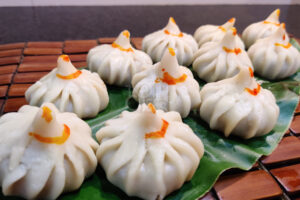 Chef Anuradha says that her family has always been very supportive. Especially her husband, who always motivated her to socialize, learn new things, and explore new opportunities. She came to know about Nativ Chefs from a reference of her friend. It was a golden opportunity for her because cooking was something that is not less than a passion for her. What fascinated her the most about the model was it believes in serving only traditional and hygienic food, and that’s what she wanted to showcase- Her homemade authentic Ukadiche Modaks!!
Chef Anuradha says that her family has always been very supportive. Especially her husband, who always motivated her to socialize, learn new things, and explore new opportunities. She came to know about Nativ Chefs from a reference of her friend. It was a golden opportunity for her because cooking was something that is not less than a passion for her. What fascinated her the most about the model was it believes in serving only traditional and hygienic food, and that’s what she wanted to showcase- Her homemade authentic Ukadiche Modaks!!
Her journey with Nativ Chefs till now has been an amazing one! And when asked about executing modaks from last year, she says, “I got this long list of preorders for modaks lined up, and the first day of Ganesh Chaturthi was pretty stressful”; but with the help of her husband and son, she was able to serve us those beautiful modaks. She summarizes the whole experience as an amazing one as this was something she always wanted to do.
Determination is the key! She recalls that she used to wake up at 4 am to prepare modaks, and she had made more than 6000 modaks!! Well, that’s the power of a home chef, which no one should underestimate. This year, even in the pandemic, she has received a lot of pre-bookings for modaks, and she is very excited to serve you the delightful authentic Ukadiche modak, which we deliver to you with utmost safety.
Chef Anuradha has been a part of various cooking shows, sometimes as a participant and even as a judge. Nativ Chefs has onboarded her other traditional delicacies as well like Upwas specials Sabudana Khichdi, Shengdana Laddu, and other festive delights like Fried Modaks, Til Gud Laddu, and many more.

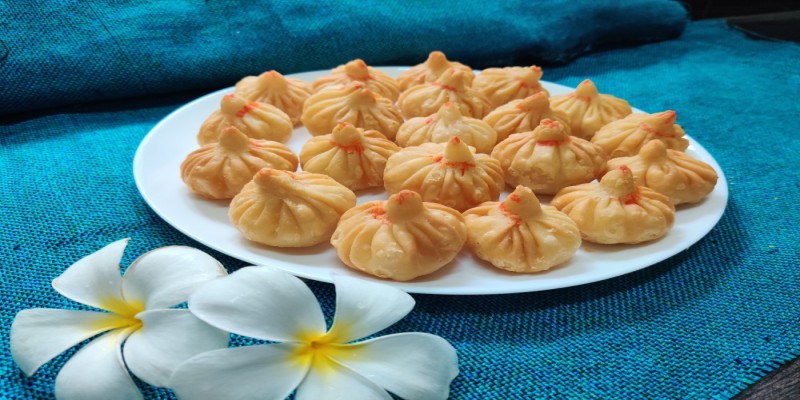
 People celebrate Ganesh Chaturthi with great enthusiasm in the states of Maharashtra, Goa, Karnataka, Madhya Pradesh, and many others. Modaks are specially served as Bhog during Ganesh Chaturthi because they are Lord Ganesha’s favorite. Ritual dictates that 21 modaks are to be served to Lord Ganesha. A lot of people are unenlightened about the story behind the 21 modaks offered to Lord Ganesha.
People celebrate Ganesh Chaturthi with great enthusiasm in the states of Maharashtra, Goa, Karnataka, Madhya Pradesh, and many others. Modaks are specially served as Bhog during Ganesh Chaturthi because they are Lord Ganesha’s favorite. Ritual dictates that 21 modaks are to be served to Lord Ganesha. A lot of people are unenlightened about the story behind the 21 modaks offered to Lord Ganesha. Talani Modaks
Talani Modaks
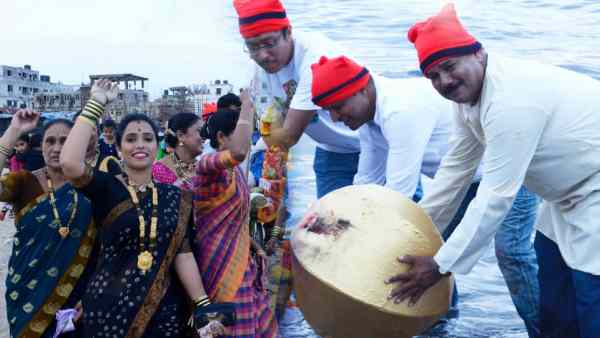
 The recipe is quite simple, you will need :
The recipe is quite simple, you will need :

 Cow’s ghee or clarified butter is rightfully considered as a superfood in our kitchen. Ghee is a great source of vitamins A, E, and helps in maintaining good cholesterol. Having a tablespoon of ghee in the morning is enough to keep your body warm for the day. What’s better? It also keeps lips and skin supple looking. Apply ghee on chapped dry lips and under your eyes and leave it overnight. Guaranteed results in three days! Now you don’t need expensive lip balms and under-eye serums anymore.
Cow’s ghee or clarified butter is rightfully considered as a superfood in our kitchen. Ghee is a great source of vitamins A, E, and helps in maintaining good cholesterol. Having a tablespoon of ghee in the morning is enough to keep your body warm for the day. What’s better? It also keeps lips and skin supple looking. Apply ghee on chapped dry lips and under your eyes and leave it overnight. Guaranteed results in three days! Now you don’t need expensive lip balms and under-eye serums anymore. An excellent substitute of sugar, honey is proven to curb high levels of blood pressure, which aids in a healthier heart function. It is rich in antigens only found in flowers that cure cold and cough. These antigens also boost immunity, thereby keeping you overall healthy.
An excellent substitute of sugar, honey is proven to curb high levels of blood pressure, which aids in a healthier heart function. It is rich in antigens only found in flowers that cure cold and cough. These antigens also boost immunity, thereby keeping you overall healthy. Amla is a rich source of vitamin C- eight times more than an orange- which is essential in strengthening immune system. It is also loaded with chromium that aids in insulin production- a lifeline for diabetic patients.
Amla is a rich source of vitamin C- eight times more than an orange- which is essential in strengthening immune system. It is also loaded with chromium that aids in insulin production- a lifeline for diabetic patients.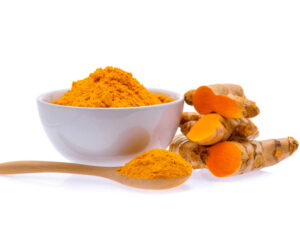 We all know Haldi as an antiseptic and anti-inflammatory wonder spice. But apart from it, it also aids bile secretion and relieves constipation which is often a problem during winters. A piece of raw turmeric or Kachchi Haldi can be added in your morning cup of tea, or a glass of warm milk with some haldi powder and honey will go a long way in keeping winter ailments at bay.
We all know Haldi as an antiseptic and anti-inflammatory wonder spice. But apart from it, it also aids bile secretion and relieves constipation which is often a problem during winters. A piece of raw turmeric or Kachchi Haldi can be added in your morning cup of tea, or a glass of warm milk with some haldi powder and honey will go a long way in keeping winter ailments at bay. In a book titled ‘Healing Foods’, ginger has established its superiority by being a quick healer of upset stomach and fighting nausea. It also keeps the body warm owing to the presence of many volatile oils in it. Adding generous amounts of ginger in morning beverages can help flush out toxins from body.
In a book titled ‘Healing Foods’, ginger has established its superiority by being a quick healer of upset stomach and fighting nausea. It also keeps the body warm owing to the presence of many volatile oils in it. Adding generous amounts of ginger in morning beverages can help flush out toxins from body.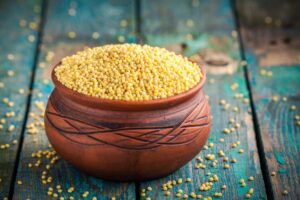 Seasonal winter crops like Bajra, Jowari, and Makka are nature’s winter gifts for our body because they are packed with all nutrients essential in facing cold temperatures. For instance, Bajra provides rich quantities of potassium and magnesium that are crucial in maintaining a healthy heart. Jowar is loaded with essential vitamins, minerals and about 50% of fibre that we need daily! Including these millets in your diet in this weather is a must. You can mix 25% of each millet flour in wheat flour to reap its nutrition every day.
Seasonal winter crops like Bajra, Jowari, and Makka are nature’s winter gifts for our body because they are packed with all nutrients essential in facing cold temperatures. For instance, Bajra provides rich quantities of potassium and magnesium that are crucial in maintaining a healthy heart. Jowar is loaded with essential vitamins, minerals and about 50% of fibre that we need daily! Including these millets in your diet in this weather is a must. You can mix 25% of each millet flour in wheat flour to reap its nutrition every day.  Sarson seeds and oil are the hidden treasures of the Indian kitchen. They are power-packed with essential fatty acids which boost immunity and promote a healthy heart. Its anti-viral and anti-bacterial properties are known to keep infections at bay. Substitute your daily refined oil with Sarson ka Tel for these few cold months and enjoy an infection-free season!
Sarson seeds and oil are the hidden treasures of the Indian kitchen. They are power-packed with essential fatty acids which boost immunity and promote a healthy heart. Its anti-viral and anti-bacterial properties are known to keep infections at bay. Substitute your daily refined oil with Sarson ka Tel for these few cold months and enjoy an infection-free season! Here’s another hidden treasure from our kitchen- flax seeds. These tiny wonders are a rich source of omega-3 fatty acids- an essential fat that our body cannot produce on its own. Just small amounts of Jawas every day can keep cholesterol levels in check. And what’s better? It also aids in weight loss as it is rich in nutrients and can keep the stomach full for a longer time. Dry roast Jawas with Jeera till it turns aromatic and stores it for a healthy after meal Mukhwas! Or get creative and experiment- have our Jawas ki Sabzi with Chawal ki Roti.
Here’s another hidden treasure from our kitchen- flax seeds. These tiny wonders are a rich source of omega-3 fatty acids- an essential fat that our body cannot produce on its own. Just small amounts of Jawas every day can keep cholesterol levels in check. And what’s better? It also aids in weight loss as it is rich in nutrients and can keep the stomach full for a longer time. Dry roast Jawas with Jeera till it turns aromatic and stores it for a healthy after meal Mukhwas! Or get creative and experiment- have our Jawas ki Sabzi with Chawal ki Roti.  Gud is a rich source of digestive enzymes, which help in regulating bowel movements and further cleanse our liver. Biting into a small piece of Gud after meals is a great way of kick-starting digestive process. Gud is also an excellent source of iron and folate that prevent amnesia. Just having a glass of warm water or milk with Gud in winters can keep your body warm. Our wide range of Laddoos prepared with Gud are also a great option to have as desserts.
Gud is a rich source of digestive enzymes, which help in regulating bowel movements and further cleanse our liver. Biting into a small piece of Gud after meals is a great way of kick-starting digestive process. Gud is also an excellent source of iron and folate that prevent amnesia. Just having a glass of warm water or milk with Gud in winters can keep your body warm. Our wide range of Laddoos prepared with Gud are also a great option to have as desserts.
 Today, their long weeks of hustle for organizing this
Today, their long weeks of hustle for organizing this  Right from selecting the menu to selecting the venue- the Nativ-team toiled for three weeks straight to organize a pleasurable evening. After exceedingly long hours of discussions and endless cups of Chai, the outline of this buffet started taking shape. A starter course, main course, and dessert from all four zones of our country were locked and sealed. There would be 22 dishes- each representing its diverse culture, straight out of our chef’s home kitchen!
Right from selecting the menu to selecting the venue- the Nativ-team toiled for three weeks straight to organize a pleasurable evening. After exceedingly long hours of discussions and endless cups of Chai, the outline of this buffet started taking shape. A starter course, main course, and dessert from all four zones of our country were locked and sealed. There would be 22 dishes- each representing its diverse culture, straight out of our chef’s home kitchen!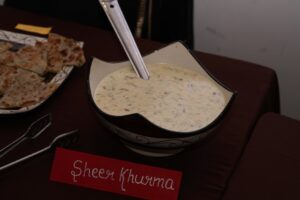

 Another guest, a well-renowned food blogger Neha Rahate from Nagpur. describes her experience and says, “This was my first dinner at Indian Treasures, and I loved it! The quality of cooking is a specimen of the expertise of their home chefs because we don’t usually get to eat authentic dishes. I think I might have a newfound love for
Another guest, a well-renowned food blogger Neha Rahate from Nagpur. describes her experience and says, “This was my first dinner at Indian Treasures, and I loved it! The quality of cooking is a specimen of the expertise of their home chefs because we don’t usually get to eat authentic dishes. I think I might have a newfound love for 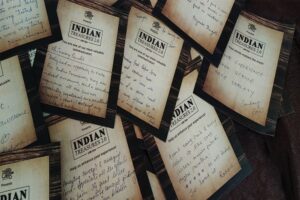 Just like every dessert needs a pinch of salt, the guests shared their feedbacks too. To this, Dixit says, “We are very well aware of our shortcomings. This was only our second attempt at buffet dinner, and we rectified our mistakes from the previous one. And we would always strive harder to serve the most authentic experience. Hopefully, the next edition will be even better!”
Just like every dessert needs a pinch of salt, the guests shared their feedbacks too. To this, Dixit says, “We are very well aware of our shortcomings. This was only our second attempt at buffet dinner, and we rectified our mistakes from the previous one. And we would always strive harder to serve the most authentic experience. Hopefully, the next edition will be even better!”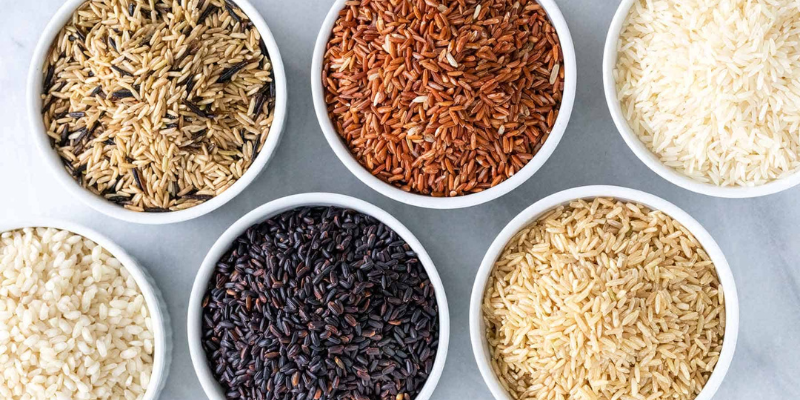
 Despite its picturesque location and Instagram-worthy holiday pictures, there is a lot about this region that we still don’t know- including its cuisine. For instance, did you know that this region alone is the largest contributor of tea to our country?
Despite its picturesque location and Instagram-worthy holiday pictures, there is a lot about this region that we still don’t know- including its cuisine. For instance, did you know that this region alone is the largest contributor of tea to our country?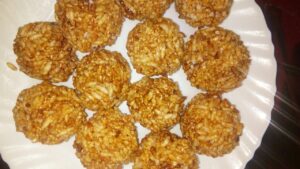 Kabok, a Laddu made from puffed rice and sugarcane syrup is a traditional dish of Manipur; while Apong, a healthy drink made from rice and millets is a local favorite of Arunachal Pradesh. Here, you will also find powdered rice used in Wungwut Ngam- a slow-cooked chicken side dish flavored with local spices.
Kabok, a Laddu made from puffed rice and sugarcane syrup is a traditional dish of Manipur; while Apong, a healthy drink made from rice and millets is a local favorite of Arunachal Pradesh. Here, you will also find powdered rice used in Wungwut Ngam- a slow-cooked chicken side dish flavored with local spices. Steering towards Nagaland, Assam, and Meghalaya- one will find the tastiest varieties of seasoned and dry-aged pork in their kitchens for round-the-year usage. Dishes thus prepared are often served with steaming hot rice and use plenty of ginger, garlic, and Bhut Jhalokia- the spiciest chillies in the world. The most beloved dish of Meghalaya is ‘Jadoh’, a type of pork biryani cooked in its fat with a different set of spices. Assamese, although not big on meat, widely use chicken, fish and duck meat in their diet along with rice, of course!
Steering towards Nagaland, Assam, and Meghalaya- one will find the tastiest varieties of seasoned and dry-aged pork in their kitchens for round-the-year usage. Dishes thus prepared are often served with steaming hot rice and use plenty of ginger, garlic, and Bhut Jhalokia- the spiciest chillies in the world. The most beloved dish of Meghalaya is ‘Jadoh’, a type of pork biryani cooked in its fat with a different set of spices. Assamese, although not big on meat, widely use chicken, fish and duck meat in their diet along with rice, of course! Rightly known as the rice bowl of India, Chattisgarhi cuisine revolves around rice dishes. Although it has many dishes to offer, their most famous contribution to breakfast- the Mona-Lisa of breakfast if you may- is the rice Chila. Made from rice and Urad dal batter, this is a quick, light and healthy start to your day. Other must-try dishes are Farra and Dubki Kadhi Chawal.
Rightly known as the rice bowl of India, Chattisgarhi cuisine revolves around rice dishes. Although it has many dishes to offer, their most famous contribution to breakfast- the Mona-Lisa of breakfast if you may- is the rice Chila. Made from rice and Urad dal batter, this is a quick, light and healthy start to your day. Other must-try dishes are Farra and Dubki Kadhi Chawal. While rice definitely forms the base for almost all south Indian dishes, the cuisine, however, is packed with spicy flavors. They have Pulihaara (tamarind rice), Pesarattu (rice batter pancake), Bisi Bele Bhaat (rice dish cooked with spices and vegetables) and the oh-so-famous
While rice definitely forms the base for almost all south Indian dishes, the cuisine, however, is packed with spicy flavors. They have Pulihaara (tamarind rice), Pesarattu (rice batter pancake), Bisi Bele Bhaat (rice dish cooked with spices and vegetables) and the oh-so-famous 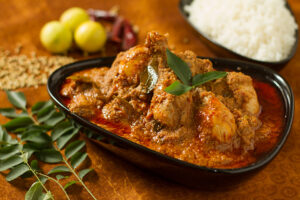 The most famous curry from Tamil Nadu- Chettinad chicken curry is a spicy blend of coconut, black peppercorns, and red chilies. This curry is also amongst one of the spiciest in our country!
The most famous curry from Tamil Nadu- Chettinad chicken curry is a spicy blend of coconut, black peppercorns, and red chilies. This curry is also amongst one of the spiciest in our country!
 Over the centuries, amidst unforgivingly cold Himalayas and scorching hot Thar desert, human life shook hands with these harsh conditions and thrived off of available resources. And ever since, our food palates have been majorly dictated by the climatic and geographic conditions.
Over the centuries, amidst unforgivingly cold Himalayas and scorching hot Thar desert, human life shook hands with these harsh conditions and thrived off of available resources. And ever since, our food palates have been majorly dictated by the climatic and geographic conditions.
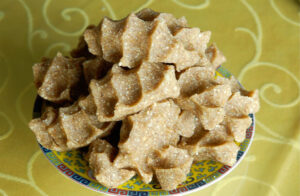
 Moving further west in the desert of Rajasthan, one can find a magnificent saturation of spices. Once ruled by the mighty prideful Rajputs, their food still reflects the same pride and hospitality. Whether it is the delicious trio of Daal Baati Churma or the sugar-laden Ghevar, you are sure to get a taste of the much talked of Rajput grandeur with every Rajasthani spread. Don’t get fooled though, one of the spiciest curries in India- Laal Maans also comes from the land of Rajputs. Spicy hot curry in blazing hot summers; seems counterintuitive, right?
Moving further west in the desert of Rajasthan, one can find a magnificent saturation of spices. Once ruled by the mighty prideful Rajputs, their food still reflects the same pride and hospitality. Whether it is the delicious trio of Daal Baati Churma or the sugar-laden Ghevar, you are sure to get a taste of the much talked of Rajput grandeur with every Rajasthani spread. Don’t get fooled though, one of the spiciest curries in India- Laal Maans also comes from the land of Rajputs. Spicy hot curry in blazing hot summers; seems counterintuitive, right?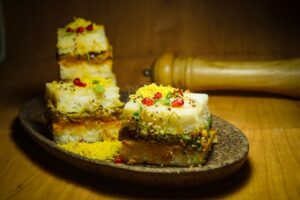 The contrasting flavors of Gujarat and Maharashtra, further down west in our map, lay the foundation of two harmoniously coexisting neighbors. While on one hand, we have the fiery spicy Misal Pav, we have the sweet but standout flavors of Khaman Dhokla and Kadhi on the other. While we relish the coconut prawns curry from Malvan, we have grown to love the sweet and tangy flavors of
The contrasting flavors of Gujarat and Maharashtra, further down west in our map, lay the foundation of two harmoniously coexisting neighbors. While on one hand, we have the fiery spicy Misal Pav, we have the sweet but standout flavors of Khaman Dhokla and Kadhi on the other. While we relish the coconut prawns curry from Malvan, we have grown to love the sweet and tangy flavors of  Being in close proximity to the sea, you will find a lot of seafood dishes clubbed with rice. Also, there is a hefty use of coconut, kokum, red Goan chillies and cashews their curries which gives it the quintessential Goan flavor. Best example being the Fish curry rice or Xitt Coddi in Konkani. It’s a simple dish that beautifully pairs chillies with kokum, served with steamed rice.
Being in close proximity to the sea, you will find a lot of seafood dishes clubbed with rice. Also, there is a hefty use of coconut, kokum, red Goan chillies and cashews their curries which gives it the quintessential Goan flavor. Best example being the Fish curry rice or Xitt Coddi in Konkani. It’s a simple dish that beautifully pairs chillies with kokum, served with steamed rice.
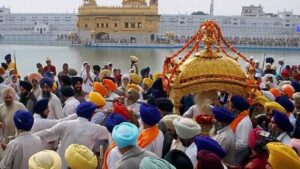 These are the opening lines of ‘Mool Mantra’, an important composition of the Sikh religious scripture, Guru Granth Sahib. These soothing lines can be heard from the Gurudwaras on Guru Nanak Jayanti which celebrates the birth anniversary of Guru Nanak. Born on full moon day of Karthik month of Hindu calendar, he was the first Sikh Guru and the establisher of Sikhism.
These are the opening lines of ‘Mool Mantra’, an important composition of the Sikh religious scripture, Guru Granth Sahib. These soothing lines can be heard from the Gurudwaras on Guru Nanak Jayanti which celebrates the birth anniversary of Guru Nanak. Born on full moon day of Karthik month of Hindu calendar, he was the first Sikh Guru and the establisher of Sikhism. Guru Nanak Jayanti is celebrated with fervent zeal and enthusiastically amongst Sikh community, mainly in the northern states of India. Throughout the day, the priests read Guru Granth Sahib from start to end without a break. Local Gurudwaras also organize various functions, Kirtans (singing religious hymns) and serve Langars (community meals) to mark this holy day. People from all walks of life and all religions can have food from these communal kitchens which are operational throughout the year. Guru Nanak was a staunch propagator of oneness and equality- he abhorred the four caste system labeled by Hinduism. The idea of Langar, too serves this ideology of all men sitting together and eating the same food.
Guru Nanak Jayanti is celebrated with fervent zeal and enthusiastically amongst Sikh community, mainly in the northern states of India. Throughout the day, the priests read Guru Granth Sahib from start to end without a break. Local Gurudwaras also organize various functions, Kirtans (singing religious hymns) and serve Langars (community meals) to mark this holy day. People from all walks of life and all religions can have food from these communal kitchens which are operational throughout the year. Guru Nanak was a staunch propagator of oneness and equality- he abhorred the four caste system labeled by Hinduism. The idea of Langar, too serves this ideology of all men sitting together and eating the same food. Eating Langar is an experience in itself. Simple Dal cooked overnight, lightly tempered with spices, fresh seasonal vegetables and piping hot Chapattis. A special sweet called Kada Prasad is the quintessential sweet offered to everyone at Gurudwara and Langar. It is made by slowly roasting whole wheat flour in a vessel full of ghee, then finishing it with sugar syrup and nut shavings.
Eating Langar is an experience in itself. Simple Dal cooked overnight, lightly tempered with spices, fresh seasonal vegetables and piping hot Chapattis. A special sweet called Kada Prasad is the quintessential sweet offered to everyone at Gurudwara and Langar. It is made by slowly roasting whole wheat flour in a vessel full of ghee, then finishing it with sugar syrup and nut shavings. A thick curd based preparation with besan fritters, nothing speaks of North India as Kadhi Pakoda. This dish is finished off with a light tempering of curry leaves and mustard seeds. The only thing better than Rajma Chawal is Kadhi
A thick curd based preparation with besan fritters, nothing speaks of North India as Kadhi Pakoda. This dish is finished off with a light tempering of curry leaves and mustard seeds. The only thing better than Rajma Chawal is Kadhi 
 But don’t get us wrong, we are not the protestors of western cuisine or unorthodoxly opposed to experimentation. We will happily devour Indian food with variations. Like the Sambar which was originally spicy, could be milder if made in a
But don’t get us wrong, we are not the protestors of western cuisine or unorthodoxly opposed to experimentation. We will happily devour Indian food with variations. Like the Sambar which was originally spicy, could be milder if made in a 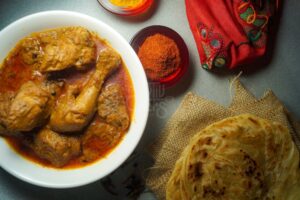 Not just the Indian palate, fusion food is an embarrassment to western cuisines as well. Every dish from a foreign land has a tale to tell- about their culture, habitat, lifestyle, and principles. For instance, the Chinese believe in harmony and balance in nature- Feng Shui and Yin Yang being the most common examples. This is also reflected in their food habits quite well- in a bowl of boiled noodles. This bowl is teamed with some
Not just the Indian palate, fusion food is an embarrassment to western cuisines as well. Every dish from a foreign land has a tale to tell- about their culture, habitat, lifestyle, and principles. For instance, the Chinese believe in harmony and balance in nature- Feng Shui and Yin Yang being the most common examples. This is also reflected in their food habits quite well- in a bowl of boiled noodles. This bowl is teamed with some